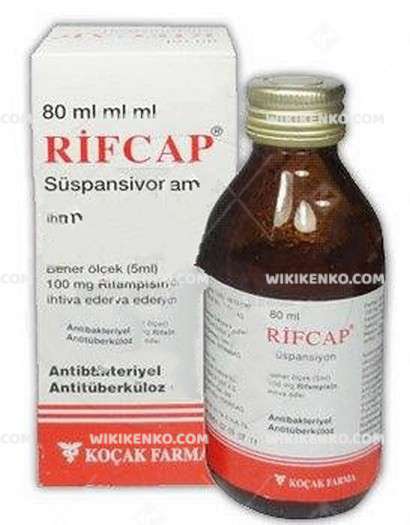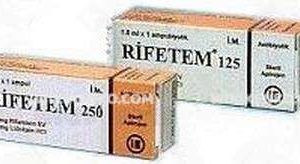Rifcap Suspension
Embark on a journey through the intricacies of Rifcap Suspension, a medication housing the potent Rifampicin. This comprehensive overview delves into its composition, mechanism of action, uses, precautions, common side effects, alcohol interactions, dosage guidelines, administration nuances, onset of action, and potential drug interactions.
| Dosage form | |
|---|---|
| Pack size | |
| Potency | 100 Mg/5Ml 80Ml |
| Manufacturer | |
| Origin | |
| Generic Name (Ingredient) | Each Scale (5 Ml) Contains 100 Mg Of Rifampicin. |
Assuming your emergency circumstances for this product, visit Urgent Quotation page. Besides, for any pharmaceutical questions, please ask us in the comments section.
Description
Composition
Unveiling the pharmaceutical symphony within Rifcap, each 300 mg capsule encapsulates Rifampicin. Auxiliary components, including Magnesium Stearate, Corn Starch, Indigo Carmine, Erythrosine, and Titanium Dioxide, contribute to its meticulous formulation.
Mechanism of Action
Rifcap’s strategic prowess lies in suppressing RNA synthesis initiation in susceptible bacteria. By binding to the β subunit of DNA-dependent RNA polymerase, it obstructs RNA transcription without impeding mammalian enzyme activity.
Rifcap Suspension Uses
Navigate Rifcap’s diverse applications, extending its shield against tuberculosis, leprosy, brucellosis, Legionnaire’s disease, Staphylococcus infections, carrier states of Haemophilus influenzae, and other serious bacterial infections. It’s also a frontline defender against Neisseria meningitidis.
Precautions
General Precautions
Exercise caution if allergic to Rifampicin or with conditions like liver disease, kidney issues (especially with doses exceeding 600 mg), diabetes, or peripheral neuropathy. Avoid usage in cases of jaundice and steer clear of Saquinavir/Ritonavir combinations.
Storage and Administration Wisdom
Ensure a well-shaken suspension before administration. Stability studies vouch for room temperature or refrigeration storage for four weeks.
Interactions with Other Medicines
Rifcap’s interaction dance may alter medication effectiveness. Full disclosure of current medications to healthcare providers is paramount.
Pregnancy and Breastfeeding Considerations
Consult healthcare providers before usage in pregnancy or breastfeeding. Regular liver function tests and bacteriologic cultures amplify monitoring precision.
Side Effects
Awareness is key in navigating Rifcap’s common side effects:
- Gastrointestinal Disturbances: Loss of appetite, nausea, vomiting, and diarrhea.
- Hepatic Disorders: Transient liver function abnormalities, occasionally progressing to hepatitis.
- Hematological Reactions: Thrombocytopenia, leukopenia, eosinophilia, and hemolytic anemia.
- Hypersensitivity Reactions: Fever, chills, headache, dizziness, and bone pain.
- Dermatological Reactions: Flushing, itching, rash, and urticaria.
Alcohol Interaction: A Cautionary Note
Rifcap and alcohol seldom make harmonious companions. The potential for intensified side effects, especially concerning liver function, emphasizes the prudence of abstaining from alcohol during Rifcap usage.
Dosage
Adults
A tailored approach prescribes a daily dosage not exceeding 600 mg, oral or IV, based on body weight.
Pediatric Patients
For pediatric precision, dosages range from 10 to 20 mg/kg, ensuring therapeutic efficacy.
Children Aged 1 Month to 18 Years
Dosages span 15mg/kg once daily (max 450mg) for body weights less than 50kg and 15mg/kg once daily (max 600mg) for 50kg or more. A meticulous dosage period of six months underscores precision in pediatric care.
Administration Wisdom
Empty stomach ingestion, either 1 hour before or 2 hours after a meal, coupled with well-shaken suspensions, orchestrates optimal therapeutic outcomes.
Onset of Action
Rifcap’s impact, akin to many antibiotics, demands patience. The onset of action varies, with observable improvements typically within hours to days. Completion of the prescribed course remains non-negotiable for sustained efficacy and resistance prevention.
Interactions of Rifcap Suspension
Rifcap’s interaction repertoire includes potential impacts on CYP450 metabolized drugs, atovaquone, and ketoconazole. Vigilance and healthcare provider consultations remain pivotal in avoiding untoward interactions.
Conclusion
In traversing the depths of Rifcap Suspension, precision aligns with therapeutic efficacy. From compositional insights to nuanced precautions, each facet underscores a commitment to patient-centric care. Always consult healthcare providers for personalized guidance, ensuring a journey through Rifcap’s realm that is informed, optimized, and attuned to individual well-being.
Rifcap Suspension at a glance
| Topic | Details |
|---|---|
| Composition | Rifampicin (300 mg), Magnesium Stearate, Corn Starch, Indigo Carmine, Erythrosine, Titanium Dioxide |
| Mechanism of Action | Inhibition of RNA synthesis in susceptible bacteria by binding to DNA-dependent RNA polymerase |
| Uses | Tuberculosis, leprosy, brucellosis, Legionnaire’s disease, Staphylococcus infections, carrier states of Haemophilus influenzae, other serious bacterial infections, prevention of Neisseria meningitidis infections |
| Precautions | Allergies to Rifampicin, liver disease, kidney issues, diabetes, peripheral neuropathy, jaundice, avoidance of Saquinavir/Ritonavir combinations |
| Common Side Effects | Gastrointestinal disturbances, hepatic disorders, hematological reactions, hypersensitivity reactions, dermatological reactions |
| Alcohol Interaction | Not recommended; may intensify side effects, especially concerning liver function |
| Dosage (Adults) | Not exceeding 600 mg daily, oral or IV, based on body weight |
| Dosage (Pediatric Patients) | 10–20 mg/kg, not exceeding 600 mg daily, oral or IV |
| Dosage (Children Aged 1 Month to 18 Years) | 15 mg/kg once daily (max 450 mg) for body weights less than 50 kg; 15 mg/kg once daily (max 600 mg) for 50 kg or more, for six months |
| Onset of Action | Variable, with observable improvements typically within hours to days |
| Interactions | CYP450 metabolized drugs, atovaquone, ketoconazole |
Use the form below to report an error
Please answer the questions as thoroughly and accurately as possible. Your answers will help us better understand what kind of mistakes happen, why and where they happen, and in the end the purpose is to build a better archive to guide researchers and professionals around the world.
The information on this page is not intended to be a substitute for professional medical advice, diagnosis, or treatment. always seek the advice for your physician or another qualified health provider with any questions you may have regarding a medical condition. Always remember to
- Ask your own doctor for medical advice.
- Names, brands, and dosage may differ between countries.
- When not feeling well, or experiencing side effects always contact your own doctor.
Cyberchondria
The truth is that when we’re sick, or worried about getting sick, the internet won’t help.
According to Wikipedia, cyberchondria is a mental disorder consisting in the desire to independently make a diagnosis based on the symptoms of diseases described on Internet sites.
Why you can't look for symptoms on the Internet
If diagnoses could be made simply from a textbook or an article on a website, we would all be doctors and treat ourselves. Nothing can replace the experience and knowledge of specially trained people. As in any field, in medicine there are unscrupulous specialists, differences of opinion, inaccurate diagnoses and incorrect test results.







Reviews
There are no reviews yet.